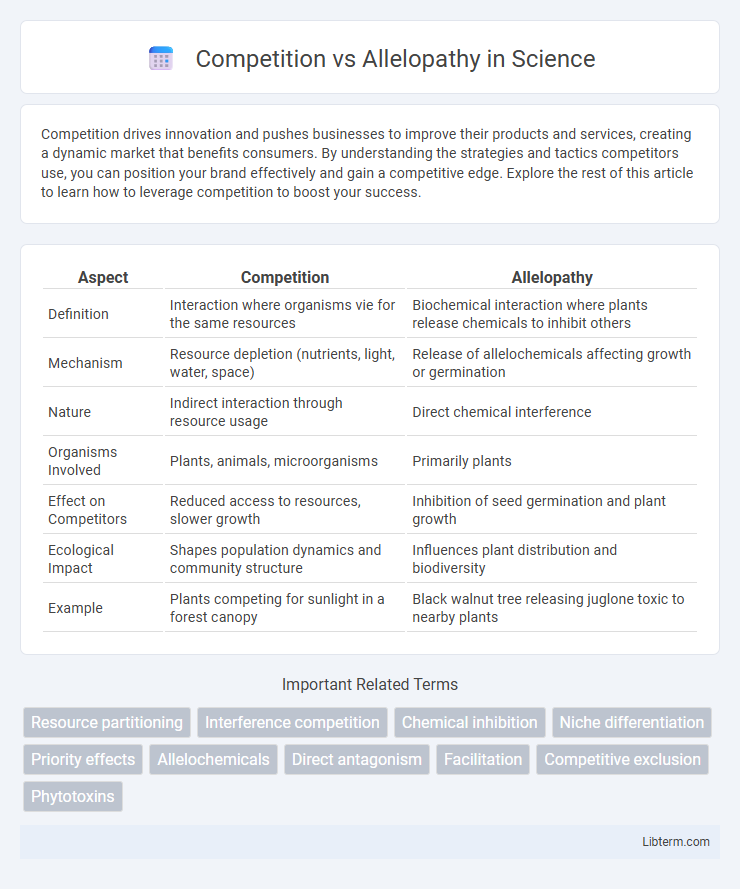Competition drives innovation and pushes businesses to improve their products and services, creating a dynamic market that benefits consumers. By understanding the strategies and tactics competitors use, you can position your brand effectively and gain a competitive edge. Explore the rest of this article to learn how to leverage competition to boost your success.
Table of Comparison
| Aspect | Competition | Allelopathy |
|---|---|---|
| Definition | Interaction where organisms vie for the same resources | Biochemical interaction where plants release chemicals to inhibit others |
| Mechanism | Resource depletion (nutrients, light, water, space) | Release of allelochemicals affecting growth or germination |
| Nature | Indirect interaction through resource usage | Direct chemical interference |
| Organisms Involved | Plants, animals, microorganisms | Primarily plants |
| Effect on Competitors | Reduced access to resources, slower growth | Inhibition of seed germination and plant growth |
| Ecological Impact | Shapes population dynamics and community structure | Influences plant distribution and biodiversity |
| Example | Plants competing for sunlight in a forest canopy | Black walnut tree releasing juglone toxic to nearby plants |
Understanding Competition in Plant Communities
Competition in plant communities involves the struggle for limited resources such as light, water, nutrients, and space, where individual plants or species negatively impact each other's growth and survival. This dynamic shapes species distribution, abundance, and community structure by influencing resource availability and niche differentiation. Understanding competition highlights how interactions regulate biodiversity and ecosystem productivity through resource allocation and adaptive strategies.
Defining Allelopathy: Chemical Interactions in Nature
Allelopathy refers to the biological phenomenon where plants release chemicals, known as allelochemicals, into the environment to inhibit the growth and development of neighboring plants, giving them a competitive advantage. Unlike general competition for resources such as water, light, and nutrients, allelopathy involves direct chemical interactions that affect seed germination, root elongation, and overall plant vitality. Key allelochemicals include phenolics, terpenoids, and alkaloids, which play a critical role in shaping plant community dynamics and ecosystem structure.
Key Differences Between Competition and Allelopathy
Competition involves the struggle between organisms for limited resources such as nutrients, water, light, and space, impacting growth and survival. Allelopathy refers to the chemical inhibition of one plant species by another through the release of bioactive compounds like phenolics and alkaloids into the environment. While competition affects resource availability directly, allelopathy influences plant interactions chemically, often leading to plant growth suppression or mortality in surrounding vegetation.
Mechanisms of Resource Competition
Competition for resources involves direct or indirect interactions where plants vie for limited nutrients, water, light, and space, often leading to reduced growth or survival of competitors. Mechanisms include root proliferation to maximize nutrient uptake, canopy expansion for light capture, and accelerated nutrient absorption rates. These strategies reduce resource availability for neighboring plants, intensifying competitive pressure and influencing community structure and biodiversity.
How Allelopathy Influences Plant Growth
Allelopathy influences plant growth by releasing biochemical compounds, such as phenolics and terpenoids, into the soil that inhibit seed germination and root development of neighboring plants. These allelochemicals alter nutrient availability and disrupt microbial communities, creating a hostile environment for competitor species. This biochemical interference provides allelopathic plants a competitive edge by reducing resource competition and enhancing their own survival and growth.
Ecological Significance of Plant Interactions
Competition and allelopathy are key ecological mechanisms influencing plant community dynamics and biodiversity. Competition primarily involves resource limitation, such as light, water, and nutrients, shaping species distribution and abundance. Allelopathy, through biochemical interactions, can suppress competitors and alter soil chemistry, directly affecting plant succession and ecosystem stability.
Case Studies: Competition vs Allelopathy in Action
Case studies examining competition versus allelopathy reveal distinct plant interaction mechanisms influencing ecosystem dynamics. Research on crop mixtures shows that allelopathic plants like black walnut inhibit neighboring species through biochemical means, while competitive species primarily compete for light, nutrients, and water resources. Experimental plots in agroecosystems demonstrate that allelopathy can suppress weeds more effectively than direct competition, indicating its potential for sustainable weed management.
Impact on Biodiversity and Ecosystem Stability
Competition and allelopathy are critical ecological interactions that influence biodiversity and ecosystem stability by controlling species distribution and population dynamics. Competitive exclusion can reduce biodiversity by favoring dominant species that outcompete others for limited resources, whereas allelopathy introduces chemical inhibition that suppresses or alters the growth of competing plant species, often leading to shifts in community composition. These interactions regulate ecosystem functionality by maintaining species balance and promoting resilience against environmental stresses, ultimately affecting nutrient cycling and habitat structure.
Implications for Agriculture and Weed Management
Competition among crops and weeds reduces resource availability such as nutrients, water, and light, leading to decreased crop yields. Allelopathy involves biochemical interactions where certain plants release natural compounds that inhibit the germination or growth of neighboring weeds, offering a potential eco-friendly weed control strategy. Integrating allelopathic crops or natural plant extracts in crop rotation and mulching can reduce reliance on synthetic herbicides, promoting sustainable agriculture and improving overall weed management efficiency.
Future Directions in Plant Interaction Research
Future research in plant interaction is shifting towards integrating molecular techniques to unravel the genetic basis of both competition and allelopathy, enhancing precision in identifying allelochemicals and their target pathways. Advances in metabolomics and gene editing tools like CRISPR/Cas9 offer promising avenues for manipulating allelopathic traits to improve crop resilience and sustainable weed management. Modeling approaches combining ecological data with molecular insights aim to predict plant community dynamics under climate change, driving informed agricultural practices and biodiversity conservation.
Competition Infographic

 libterm.com
libterm.com